Bin Liang
Memory-T1: Reinforcement Learning for Temporal Reasoning in Multi-session Agents
Dec 23, 2025Abstract:Temporal reasoning over long, multi-session dialogues is a critical capability for conversational agents. However, existing works and our pilot study have shown that as dialogue histories grow in length and accumulate noise, current long-context models struggle to accurately identify temporally pertinent information, significantly impairing reasoning performance. To address this, we introduce Memory-T1, a framework that learns a time-aware memory selection policy using reinforcement learning (RL). It employs a coarse-to-fine strategy, first pruning the dialogue history into a candidate set using temporal and relevance filters, followed by an RL agent that selects the precise evidence sessions. The RL training is guided by a multi-level reward function optimizing (i) answer accuracy, (ii) evidence grounding, and (iii) temporal consistency. In particular, the temporal consistency reward provides a dense signal by evaluating alignment with the query time scope at both the session-level (chronological proximity) and the utterance-level (chronological fidelity), enabling the agent to resolve subtle chronological ambiguities. On the Time-Dialog benchmark, Memory-T1 boosts a 7B model to an overall score of 67.0\%, establishing a new state-of-the-art performance for open-source models and outperforming a 14B baseline by 10.2\%. Ablation studies show temporal consistency and evidence grounding rewards jointly contribute to a 15.0\% performance gain. Moreover, Memory-T1 maintains robustness up to 128k tokens, where baseline models collapse, proving effectiveness against noise in extensive dialogue histories. The code and datasets are publicly available at https://github.com/Elvin-Yiming-Du/Memory-T1/
Semi-distributed Cross-modal Air-Ground Relative Localization
Nov 10, 2025Abstract:Efficient, accurate, and flexible relative localization is crucial in air-ground collaborative tasks. However, current approaches for robot relative localization are primarily realized in the form of distributed multi-robot SLAM systems with the same sensor configuration, which are tightly coupled with the state estimation of all robots, limiting both flexibility and accuracy. To this end, we fully leverage the high capacity of Unmanned Ground Vehicle (UGV) to integrate multiple sensors, enabling a semi-distributed cross-modal air-ground relative localization framework. In this work, both the UGV and the Unmanned Aerial Vehicle (UAV) independently perform SLAM while extracting deep learning-based keypoints and global descriptors, which decouples the relative localization from the state estimation of all agents. The UGV employs a local Bundle Adjustment (BA) with LiDAR, camera, and an IMU to rapidly obtain accurate relative pose estimates. The BA process adopts sparse keypoint optimization and is divided into two stages: First, optimizing camera poses interpolated from LiDAR-Inertial Odometry (LIO), followed by estimating the relative camera poses between the UGV and UAV. Additionally, we implement an incremental loop closure detection algorithm using deep learning-based descriptors to maintain and retrieve keyframes efficiently. Experimental results demonstrate that our method achieves outstanding performance in both accuracy and efficiency. Unlike traditional multi-robot SLAM approaches that transmit images or point clouds, our method only transmits keypoint pixels and their descriptors, effectively constraining the communication bandwidth under 0.3 Mbps. Codes and data will be publicly available on https://github.com/Ascbpiac/cross-model-relative-localization.git.
Robust and High-Fidelity 3D Gaussian Splatting: Fusing Pose Priors and Geometry Constraints for Texture-Deficient Outdoor Scenes
Nov 10, 2025Abstract:3D Gaussian Splatting (3DGS) has emerged as a key rendering pipeline for digital asset creation due to its balance between efficiency and visual quality. To address the issues of unstable pose estimation and scene representation distortion caused by geometric texture inconsistency in large outdoor scenes with weak or repetitive textures, we approach the problem from two aspects: pose estimation and scene representation. For pose estimation, we leverage LiDAR-IMU Odometry to provide prior poses for cameras in large-scale environments. These prior pose constraints are incorporated into COLMAP's triangulation process, with pose optimization performed via bundle adjustment. Ensuring consistency between pixel data association and prior poses helps maintain both robustness and accuracy. For scene representation, we introduce normal vector constraints and effective rank regularization to enforce consistency in the direction and shape of Gaussian primitives. These constraints are jointly optimized with the existing photometric loss to enhance the map quality. We evaluate our approach using both public and self-collected datasets. In terms of pose optimization, our method requires only one-third of the time while maintaining accuracy and robustness across both datasets. In terms of scene representation, the results show that our method significantly outperforms conventional 3DGS pipelines. Notably, on self-collected datasets characterized by weak or repetitive textures, our approach demonstrates enhanced visualization capabilities and achieves superior overall performance. Codes and data will be publicly available at https://github.com/justinyeah/normal_shape.git.
ReMoD: Rethinking Modality Contribution in Multimodal Stance Detection via Dual Reasoning
Nov 08, 2025Abstract:Multimodal Stance Detection (MSD) is a crucial task for understanding public opinion on social media. Existing work simply fuses information from various modalities to learn stance representations, overlooking the varying contributions of stance expression from different modalities. Therefore, stance misunderstanding noises may be drawn into the stance learning process due to the risk of learning errors by rough modality combination. To address this, we get inspiration from the dual-process theory of human cognition and propose **ReMoD**, a framework that **Re**thinks **Mo**dality contribution of stance expression through a **D**ual-reasoning paradigm. ReMoD integrates *experience-driven intuitive reasoning* to capture initial stance cues with *deliberate reflective reasoning* to adjust for modality biases, refine stance judgments, and thereby dynamically weight modality contributions based on their actual expressive power for the target stance. Specifically, the intuitive stage queries the Modality Experience Pool (MEP) and Semantic Experience Pool (SEP) to form an initial stance hypothesis, prioritizing historically impactful modalities. This hypothesis is then refined in the reflective stage via two reasoning chains: Modality-CoT updates MEP with adaptive fusion strategies to amplify relevant modalities, while Semantic-CoT refines SEP with deeper contextual insights of stance semantics. These dual experience structures are continuously refined during training and recalled at inference to guide robust and context-aware stance decisions. Extensive experiments on the public MMSD benchmark demonstrate that our ReMoD significantly outperforms most baseline models and exhibits strong generalization capabilities.
Distribution Preference Optimization: A Fine-grained Perspective for LLM Unlearning
Oct 06, 2025Abstract:As Large Language Models (LLMs) demonstrate remarkable capabilities learned from vast corpora, concerns regarding data privacy and safety are receiving increasing attention. LLM unlearning, which aims to remove the influence of specific data while preserving overall model utility, is becoming an important research area. One of the mainstream unlearning classes is optimization-based methods, which achieve forgetting directly through fine-tuning, exemplified by Negative Preference Optimization (NPO). However, NPO's effectiveness is limited by its inherent lack of explicit positive preference signals. Attempts to introduce such signals by constructing preferred responses often necessitate domain-specific knowledge or well-designed prompts, fundamentally restricting their generalizability. In this paper, we shift the focus to the distribution-level, directly targeting the next-token probability distribution instead of entire responses, and derive a novel unlearning algorithm termed \textbf{Di}stribution \textbf{P}reference \textbf{O}ptimization (DiPO). We show that the requisite preference distribution pairs for DiPO, which are distributions over the model's output tokens, can be constructed by selectively amplifying or suppressing the model's high-confidence output logits, thereby effectively overcoming NPO's limitations. We theoretically prove the consistency of DiPO's loss function with the desired unlearning direction. Extensive experiments demonstrate that DiPO achieves a strong trade-off between model utility and forget quality. Notably, DiPO attains the highest forget quality on the TOFU benchmark, and maintains leading scalability and sustainability in utility preservation on the MUSE benchmark.
ReSURE: Regularizing Supervision Unreliability for Multi-turn Dialogue Fine-tuning
Aug 27, 2025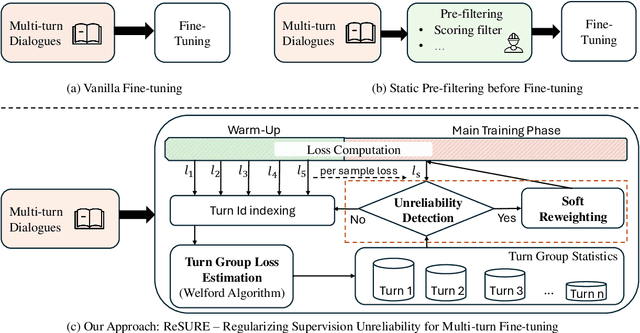



Abstract:Fine-tuning multi-turn dialogue systems requires high-quality supervision but often suffers from degraded performance when exposed to low-quality data. Supervision errors in early turns can propagate across subsequent turns, undermining coherence and response quality. Existing methods typically address data quality via static prefiltering, which decouples quality control from training and fails to mitigate turn-level error propagation. In this context, we propose ReSURE (Regularizing Supervision UnREliability), an adaptive learning method that dynamically down-weights unreliable supervision without explicit filtering. ReSURE estimates per-turn loss distributions using Welford's online statistics and reweights sample losses on the fly accordingly. Experiments on both single-source and mixed-quality datasets show improved stability and response quality. Notably, ReSURE enjoys positive Spearman correlations (0.21 ~ 1.0 across multiple benchmarks) between response scores and number of samples regardless of data quality, which potentially paves the way for utilizing large-scale data effectively. Code is publicly available at https://github.com/Elvin-Yiming-Du/ReSURE_Multi_Turn_Training.
HOTA: Hierarchical Overlap-Tiling Aggregation for Large-Area 3D Flood Mapping
Jul 10, 2025Abstract:Floods are among the most frequent natural hazards and cause significant social and economic damage. Timely, large-scale information on flood extent and depth is essential for disaster response; however, existing products often trade spatial detail for coverage or ignore flood depth altogether. To bridge this gap, this work presents HOTA: Hierarchical Overlap-Tiling Aggregation, a plug-and-play, multi-scale inference strategy. When combined with SegFormer and a dual-constraint depth estimation module, this approach forms a complete 3D flood-mapping pipeline. HOTA applies overlapping tiles of different sizes to multispectral Sentinel-2 images only during inference, enabling the SegFormer model to capture both local features and kilometre-scale inundation without changing the network weights or retraining. The subsequent depth module is based on a digital elevation model (DEM) differencing method, which refines the 2D mask and estimates flood depth by enforcing (i) zero depth along the flood boundary and (ii) near-constant flood volume with respect to the DEM. A case study on the March 2021 Kempsey (Australia) flood shows that HOTA, when coupled with SegFormer, improves IoU from 73\% (U-Net baseline) to 84\%. The resulting 3D surface achieves a mean absolute boundary error of less than 0.5 m. These results demonstrate that HOTA can produce accurate, large-area 3D flood maps suitable for rapid disaster response.
MISCGrasp: Leveraging Multiple Integrated Scales and Contrastive Learning for Enhanced Volumetric Grasping
Jul 03, 2025Abstract:Robotic grasping faces challenges in adapting to objects with varying shapes and sizes. In this paper, we introduce MISCGrasp, a volumetric grasping method that integrates multi-scale feature extraction with contrastive feature enhancement for self-adaptive grasping. We propose a query-based interaction between high-level and low-level features through the Insight Transformer, while the Empower Transformer selectively attends to the highest-level features, which synergistically strikes a balance between focusing on fine geometric details and overall geometric structures. Furthermore, MISCGrasp utilizes multi-scale contrastive learning to exploit similarities among positive grasp samples, ensuring consistency across multi-scale features. Extensive experiments in both simulated and real-world environments demonstrate that MISCGrasp outperforms baseline and variant methods in tabletop decluttering tasks. More details are available at https://miscgrasp.github.io/.
Bridging the Long-Term Gap: A Memory-Active Policy for Multi-Session Task-Oriented Dialogue
May 26, 2025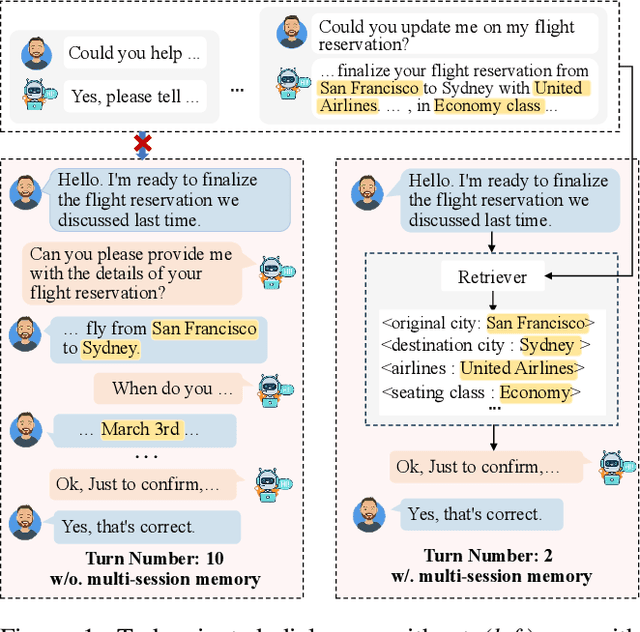
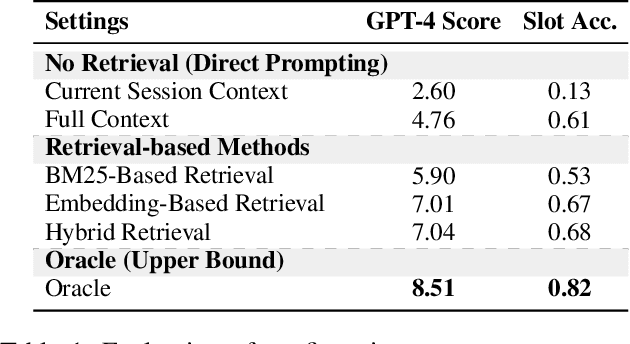
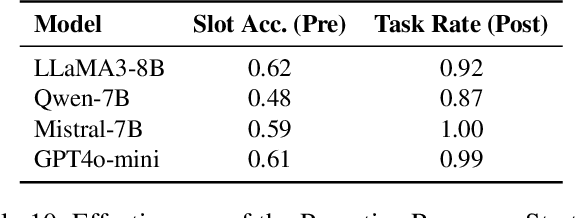
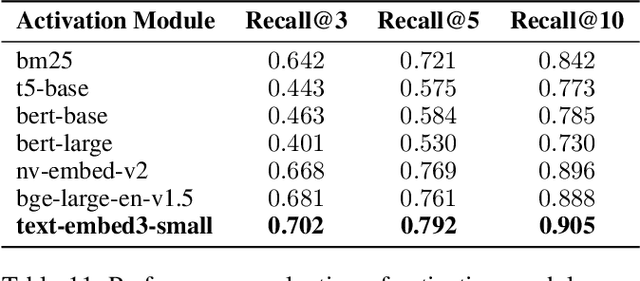
Abstract:Existing Task-Oriented Dialogue (TOD) systems primarily focus on single-session dialogues, limiting their effectiveness in long-term memory augmentation. To address this challenge, we introduce a MS-TOD dataset, the first multi-session TOD dataset designed to retain long-term memory across sessions, enabling fewer turns and more efficient task completion. This defines a new benchmark task for evaluating long-term memory in multi-session TOD. Based on this new dataset, we propose a Memory-Active Policy (MAP) that improves multi-session dialogue efficiency through a two-stage approach. 1) Memory-Guided Dialogue Planning retrieves intent-aligned history, identifies key QA units via a memory judger, refines them by removing redundant questions, and generates responses based on the reconstructed memory. 2) Proactive Response Strategy detects and correct errors or omissions, ensuring efficient and accurate task completion. We evaluate MAP on MS-TOD dataset, focusing on response quality and effectiveness of the proactive strategy. Experiments on MS-TOD demonstrate that MAP significantly improves task success and turn efficiency in multi-session scenarios, while maintaining competitive performance on conventional single-session tasks.
T$^2$: An Adaptive Test-Time Scaling Strategy for Contextual Question Answering
May 23, 2025Abstract:Recent advances in Large Language Models (LLMs) have demonstrated remarkable performance in Contextual Question Answering (CQA). However, prior approaches typically employ elaborate reasoning strategies regardless of question complexity, leading to low adaptability. Recent efficient test-time scaling methods introduce budget constraints or early stop mechanisms to avoid overthinking for straightforward questions. But they add human bias to the reasoning process and fail to leverage models' inherent reasoning capabilities. To address these limitations, we present T$^2$: Think-to-Think, a novel framework that dynamically adapts reasoning depth based on question complexity. T$^2$ leverages the insight that if an LLM can effectively solve similar questions using specific reasoning strategies, it can apply the same strategy to the original question. This insight enables to adoption of concise reasoning for straightforward questions while maintaining detailed analysis for complex problems. T$^2$ works through four key steps: decomposing questions into structural elements, generating similar examples with candidate reasoning strategies, evaluating these strategies against multiple criteria, and applying the most appropriate strategy to the original question. Experimental evaluation across seven diverse CQA benchmarks demonstrates that T$^2$ not only achieves higher accuracy than baseline methods but also reduces computational overhead by up to 25.2\%.
 Add to Chrome
Add to Chrome Add to Firefox
Add to Firefox Add to Edge
Add to Edge